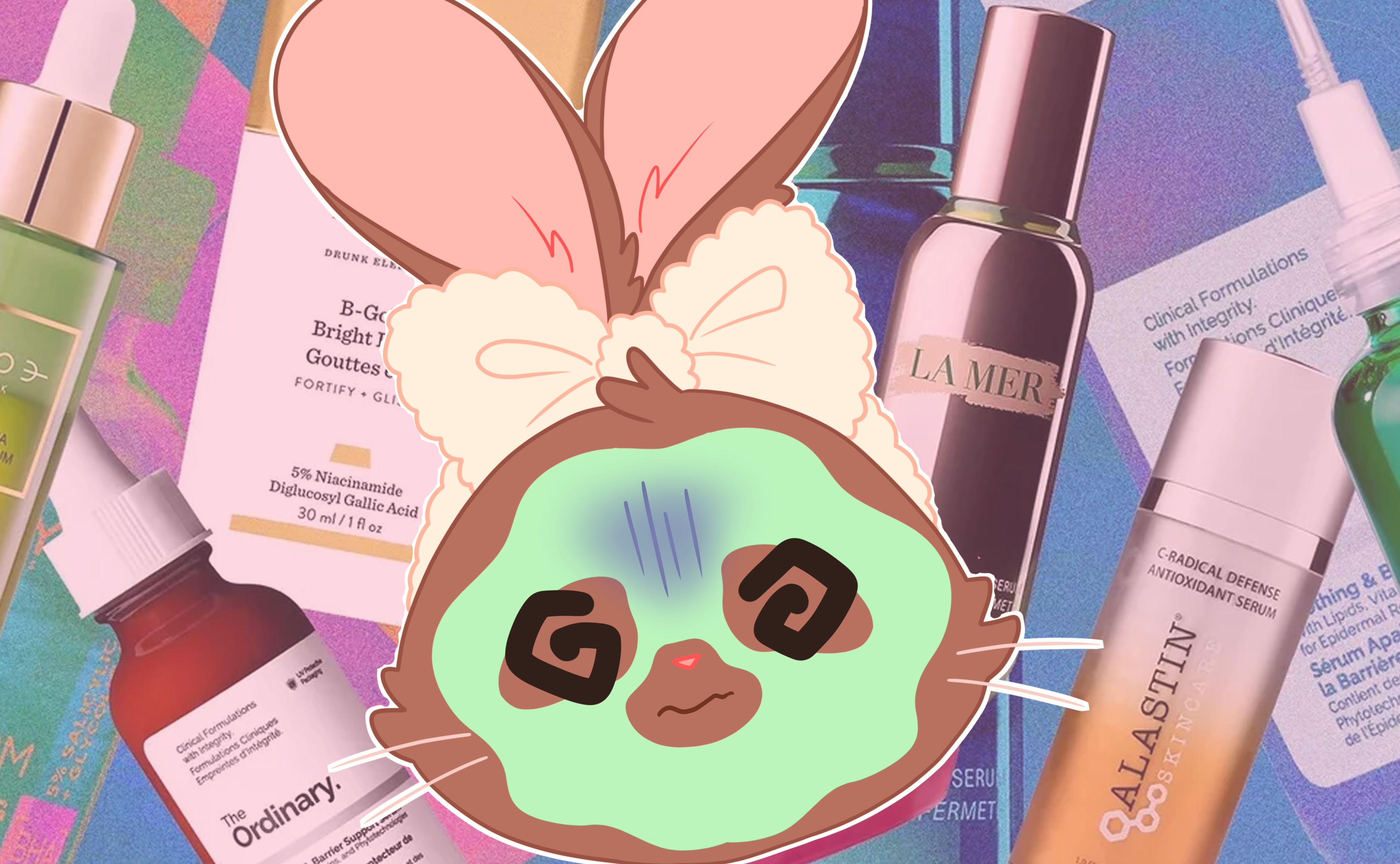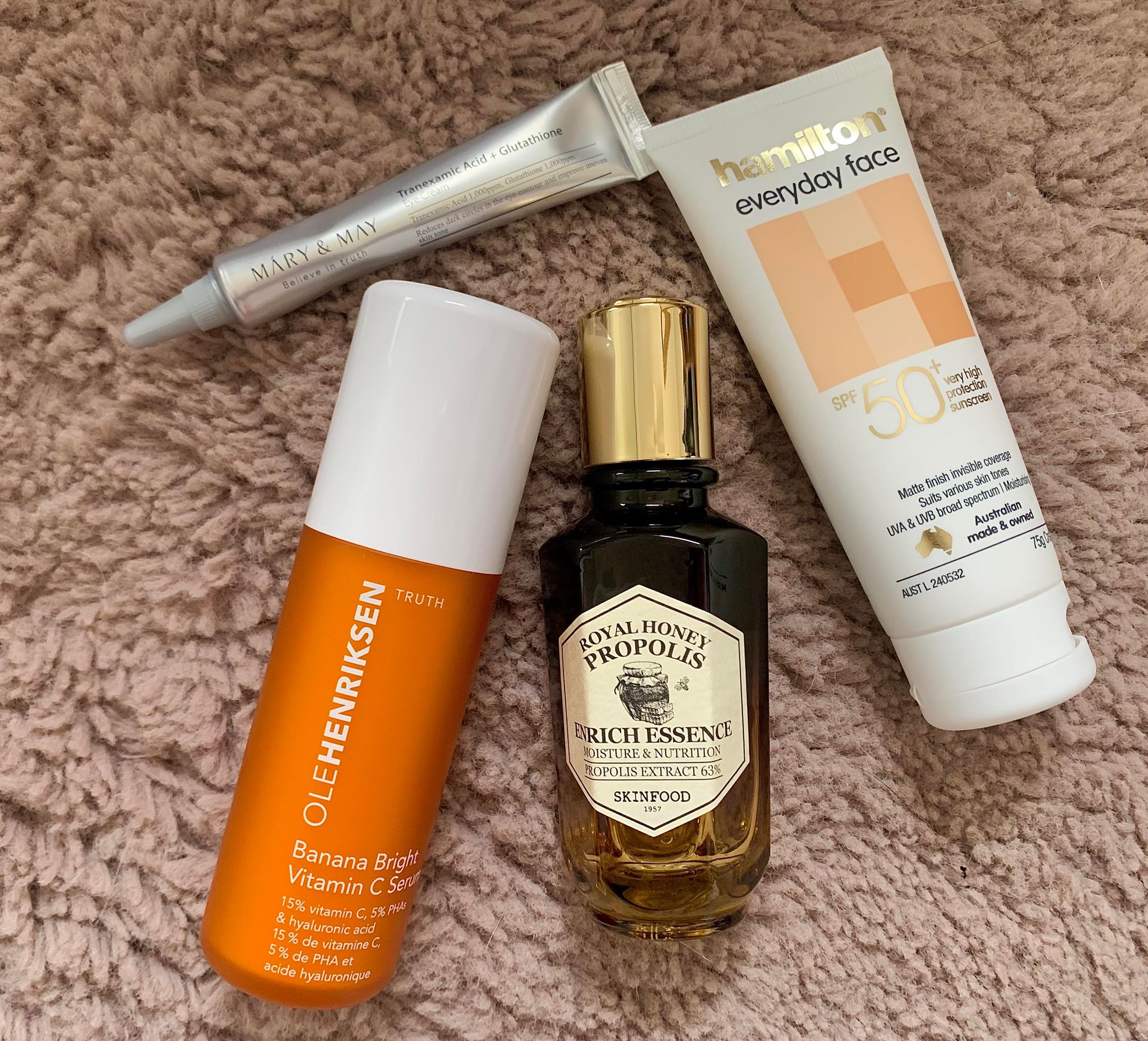Are serums a scam? The short answer is: no.
Inherently, serums are not a scam product. They might seem that way, with companies coming out with brightly coloured or pretty little potions, telling us to mix them all together like a cosmetic chemist, making a skincare ‘smoothie’!
But serums are actually a very important part of a routine! No, serums are not strictly necessary, if you want a simple routine all you really need is a cleanser, a moisturiser and a sunscreen, but if you want to dive into the world of navigating serums, read on!

The Ordinary’s Hyaluronic Acid is a great example, listing the main components of the serums, and any main percentages (2% Hyaluronic acid) on the front. This serum is great for dry skin as it helps the skin more readily take in moisture, instead of drying out.
What Do Serums Do Though?
Well that depends on the serum!
Over all, serums are targeted treatments that are aimed at specific skincare concerns. If someone is experiencing oily skin, blackheads or breakouts they might consider adding a salicylic acid serum to help regulate their pore health.
If someone is feeling like their skin is dull, dry and lifeless, they may add a vitamin C serum to help brighten and even out their skin tone.
Serums are usually very watery in consistency, and have a more concentrated amount of the ‘active ingredients’ (the ingredients meant to target your specific concerns). The thinking with this is that a larger amount of these ‘active’ molecules will potentially penetrate the skin further than a moisturiser or cleanser would.
Therefore you’re getting a higher dose of good ingredients, they are penetrating deeper for optimum effectiveness and you will hopefully be able to see results quicker!
But how do I use a serum? It can be confusing, huh? Well don’t start trying to mix and match straight away, no matter what social media tells you, let’s start slow!

The CeraVe retinol serum is a great way to add a retinol into your routine! This one is specifically for acne prone skin as it includes niacinamide for redness and scarring, ceramides for skin repair, and licorice root extract for pore health and oil control!
How Do I Use A Serum?
Say your skin was feeling dry, flakey and your makeup was separating or looking cakey. You want more hydration and your moisturiser isn’t cutting it!
You might look into a Hyaluronic acid serum! Hyaluronic acid is great for hydration, because it is a humectant, something that helps the skin hold onto water instead of drying out throughout the day.
After you cleanse with your face wash and wash it off, you’re going to pat your skin MOSTLY dry. Leave it a little bit damp!
Now, it’s serum time. Most serums come with a dropper or a pump, due to their liquidy consistency. Apply 2-3 drops of serum into your hand, rub your hands together briefly so they are coated, and then gently rub or pat the serum into your skin.
You want to keep going for around 10-20 seconds, until the serum has mostly rubbed in and your skin isn’t feeling wet. Leaving your skin damp will give the serum water to bind to, helping it lock in that hydration and absorb effectively. You do not need to wash off a serum, it is a leave on treatment.
Now don’t forget your moisturiser! You applied that concentrated dose of hydration, now you need to lock it in! Once you feel like your serum has absorbed enough, apply your moisturiser over the top to lock in all that goodness.
With a Hyaluronic acid serum specifically, you can use it morning and night time, every day if you want. Not all serums will be like that, and some can not be mixed together, but let’s leave that journey for another post.
How Do I Spot A Scam?
It Can be hard sorting through the wide and wonderful world of serums, so here are some RED FLAGS to look out for when searching for your perfect serum match!
Red Flag 1: Buzzwords
It has words like ‘detox’ ‘peel’ ‘purify’ or ‘toxin free’ on it. While this won’t apply to all serums, it will apply to most!
Most of these words come from the ‘clean beauty’ trend, where companies suddenly tried to convince us that everything was filled with toxic chemicals that were built up in our body and poisoning us, and we all need to detox!
Guess what?
If you have kidneys, congratulations, you are already ‘toxin’ free!
Our body is really good at screening for any harmful things in our system, and we have built in organs that ‘detox’ for us!
That serum with activated charcoal that claims is going to go deep into your skin are draw out all your impurities? Maybe don’t add that one to cart
Red Flag 2: Appearance
Is it filled with glitter, or tiny beads, or fun shapes? Don’t get me wrong, serums like this might not be harmful (as long as they don’t use micro plastics or unethically sourced mica), they can be fun, and make us feel good!
But if you have sensitive or acne prone skin, or are looking for effective, result driven skincare, these probably aren’t the serums for you.
There is no benefit to little bursting beads, or pretty shimmery glitter on the skin and they may even prevent the serum from properly absorbing or layering well with other products in your routine.
Red Flag 3: Unsupported Claims
It claims to be an active (retinol or vitamin C, etc.) but has no percentages listed anywhere on it.
If a skincare item has actives at a high enough percentage to be effective, then it will need to list those percentages SOMEWHERE. For an easy example, think of The Ordinary brand!
Niacinamide 10%, retinol 0.5%, lactic acid 10%, etc. etc. These ingredients can cause potential irritation by jumping up to a high dose too quickly, so brands need to be transparent about what percentage of ingredient is in the product.
If you find a retinol serum with no listed percentages on the bottle, or no easy answer pops up on a website or Google, then the percentage is most likely so low that it’s doing absolutely nothing and they aren’t required to list it.
If you want an effective serum that actually works, look for the percentages!
Red Flag 4: Essential Oils are not Essential
Does it say ‘essential oils’ anywhere on the package? Sensitive skin red flag!
Essential oils can cause serious irritation and burns to the skin in undiluted or too high quantities, especially to delicate areas like under the eyes and around the nose and mouth.
If you have especially sensitive or reactive skin, stay away from products that list essential oils, or have things like ‘lavender, bergamot or citrus peel’ in the ingredients list.
You can find more effective serums without these ingredients that are going to be better for you!
Red Flag 5: Fragrance, Fragrance, Fragrance
You see Limonene, Linalool, parfum, or dyes ( e.g.: D&C Yellow #11) listed in the ingredients list. I don’t mean to demonize fragrance, and not all serums or products that have fragrance in them are going to be bad or ineffective.
However, it’s another warning that, for sensitive skin folks, this serum might not to for you. Fragrance additives have the potential to be irritating, so always patch test a new product before use, especially if it included added fragrance or dyes.
Also, if four different names for fragrance take up most of the ingredients list, then that serum is going to be like a smelly water, and not as effective as something that’s been formulated with a thought out ingredients list full of things that can help!
Phew, Okay, What About A Good Serum?
Let’s run though some brief GREEN FLAGS of just a handful of things you can look for , keep in mind that there are many more helpful ingredients out there, but these are the most common.
- Green Tea
- Aloe Vera
- Birch Juice
- Centella Asiatica
- Willow Bark
- Cetearyl Alcohol
- Glycerin
- Dimethicone
- Vitamin E
- Jojoba Oil
- Grape Seed Oil
- Squalane
If you want to know more about the benefits of any of these ingredients, or have a dedicated post to some green flags of the ingredients list, leave a comment or shoot me an email and let me know!

A great serum for acne prone skin, clogged pores, blackheads and oily skin; AHAs are chemical exfoliants which help break down the gunk that gathers in our pores and helps keep them clear to prevent build up and skin issues.
Conclusions:
So hopefully you’ve left this article a little more armed with info, to enter into the wide and wonderful world of serums!
With all that choice out there, it can definitely be overwhelming! Try looking for percentages, avoiding ‘clean beauty toxin free’ language, and don’t be afraid to Google brands and check out their reviews!
If you are in Australia, some reputable and affordable brands to get you started are: La Roche Posay, Bondi Sands, Avene, The Ordinary, Dermaveen, Boost Labs and Bioderma.
These brands are available at Priceline and chemist warehouse, and so are an affordable and accessible place to start!
Don’t go over board, and patch test every new product as you add it into your routine one at a time. Skincare is a journey, not a race, so keep in mind that your skin will take time to show the results you are looking for.
Hang in there, read your ingredients list, and always remember to reapply your sunscreen!



